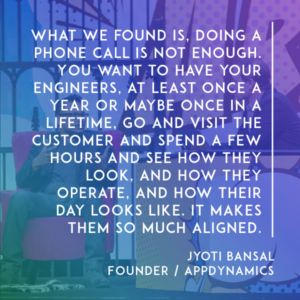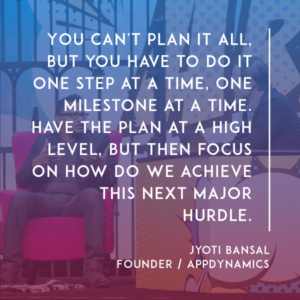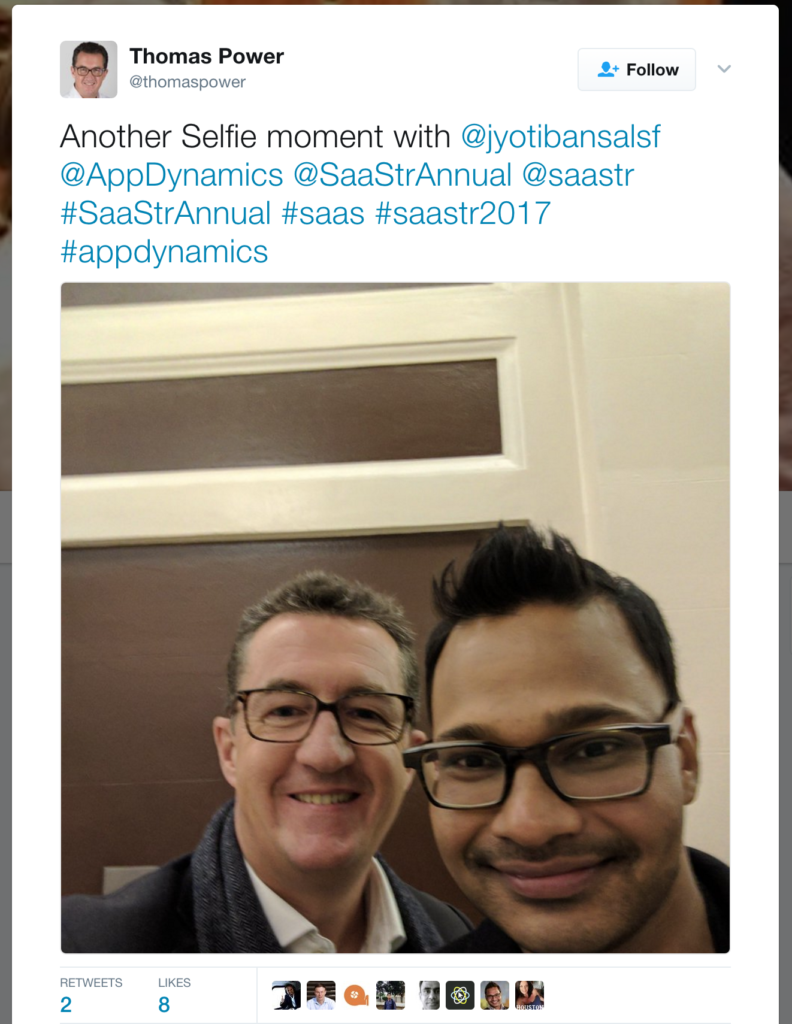 Jyoti Bansal, Founder & Chairman of AppDynamics joined SaaStr’s Jason Lemkin on stage at SaaStr Annual 2017 to give us the inside scoop on his 11th-hour decision to sell to Cisco rather than going public — and the path he took to get IPO-ready.
Jyoti Bansal, Founder & Chairman of AppDynamics joined SaaStr’s Jason Lemkin on stage at SaaStr Annual 2017 to give us the inside scoop on his 11th-hour decision to sell to Cisco rather than going public — and the path he took to get IPO-ready.
Jason opened the ‘17 Annual with an acknowledgment of the global nature of the SaaStr community — we had 47 countries represented this year, but more than 30 attendees were forced to cancel due to the travel ban — and an announcement that SaaStr had joined the immigration amicus brief. In our closing session of 2017, Jyoti’s story illustrated why diversity and immigration reform are integral to the health of the economy and the tech community: he began his SaaS journey as an immigrant engineer, waiting seven years for the US green card that would finally allow him to start AppDynamics. Read on for his advice to young engineers with similar aspirations, lessons on hiring for hypergrowth, learnings from pitching 20 VCs, and why he believes founders need to always be selling.
And if you haven’t heard: SaaStr Annual will be back in 2018, bigger and better than ever! Join 20,000 fellow founders, investors and execs for 3 days of unparalleled networking and epic learnings from SaaS legends like Jyoti, Aaron Levie, Josh James, and Dustin Moskovitz. If you don’t have tickets, lock in Early Bird pricing today and bring your team from just $499! Get tickets here.
Transcript
Jason Lemkin: Let’s give it up for Jyoti. That’s pretty cool.
Jason: Thanks for coming. This is great.
Jyoti Bansal: Yeah, definitely.
Jason: Internet times, it seems like months ago, when did this deal get announced?
Jyoti: On the 16th.
Jason: 16th?
Jyoti: Yes.
Jason: All right.
Jyoti: A few weeks now.
Jason: A few weeks now.
Jyoti: It’s moving so fast, hard to track.
Jason: Congratulations. I want to talk about other things. Just one thing on the acquisition but because it is crazy, how does it feel? It’s not like AppDynamics is a brand new company. The company’s doing hundreds of millions in revenue. How does it feel?
Jyoti: It’s been a crazy ride because we were on deep in the IPO path.
Jason: As deep as you can get.
Jyoti: Yes. The truth is before the IPO, everything was tracking really well. The real excitement, this was the first tech IPO of the year and all that. Suddenly, we’ve got this deal and everything moved so fast. That was the roller coaster part of it. As a founder, there is always a bittersweet part of selling your company.
Jason: It’s a little bittersweet.
Jyoti: You have been doing it for eight, nine years, and now you sell it. There is that part, as well.
Jason: There is a little bittersweet, even now?
Jyoti: Yeah.
Jason: A little bittersweet. Let’s go back. I want to talk about a couple things early in time. I want to go back.
First, let’s go back to the magic moment. Then, I want to go back to how you got the company off the ground, for fun, but AppDynamics, and actually give folks…Sorry. I should step back. I’m a fan, but give folks 90 seconds on what the company does. I should have started there.
Jyoti: What AppDynamics does is it builds application monitoring and intelligence. Everyone has apps. You all are probably building some kind of app, a website, a mobile app, or some kind of software.
AppDynamics makes sure that if something goes wrong, you can troubleshoot, figure out what’s wrong, and optimize your apps.
Jason: You were at Wily before that. Was Wily your first big role?
Jyoti: I was at Wily as an engineer and architect.
Jason: Your life’s been in APM. What was the white space that you saw? Why did you go for it?
Jyoti: I saw two white spaces. One was more of a technology white space. APM was there. People are building monitoring for apps, but the apps were going through this big transformation of becoming more distributed.
When you do a click, does it go to two or three servers, or does it go to 20, 30 different servers? That was the transformation that was very obvious that’s going to happen, with cloud, DevOps, microservices, and all that stuff.
To me, that was the technology white space. I knew that we would need a next generation of APM. There was also a business model white space. This was 2008, right?
Jason: Yeah, perfect time to do a startup, right?
Jyoti: Yes. [laughs]
Jason: Everyone else was just throwing money all around. It was the easiest time, right?
Jyoti: If you look at every enterprise software category then, it was going through that change on consumerization of enterprise software. CRM going from Siebel to Salesforce, and HRM going from PeopleSoft to Workday. The enterprise infrastructure like monitoring and logging and security, they were just starting to go through that.
I also saw the white space that we can do a business model deception, we can bring that consumerization for this infrastructure software, make it easy, simple and take simplicity as a competitor advantage.
Jason: Got it. You saw that, but it took a few iterations to get it right. What did you get wrong in the beginning?
Jyoti: I saw the white space. I knew the market was large and I had a hypothesis on the solution, how I would solve it. There were two things wrong in my hypothesis there.
One, the first assumption that was wrong was, I thought, if you want to build a next generation of APM, you have to build a closed loop system, where, as a developer, you tell us that I want one second response time for when someone does a checkout from shopping cart and the system takes care of it automatically. You don’t have to do anything like scale up, scale down and provisioning of capacity and all those things.
It turned out that we were too early for that. The world wasn’t ready for that. It’s like people wanted just monitoring and data, to begin with, because going into advanced closed loop was much further ahead. That was the first pivot we do.
If you looked at now the serverless movement and what Amazon AWS, Lambda and all, it is about that closed loop system that I was trying to do back then.
Jason: You were three to four years too early?
Jyoti: Yeah. That was the first pivot for us. The second one was more about really where do you store the data. At that time, it’s like if you would start a company and you were doing anything on premise, you would look stupid. Everyone would be, “Why are you doing anything on premise?”
That was our assumption as well. We were like everything was SaaS, everything was in the cloud, and we’re trying just to go and talk with these large enterprises.
What we learnt was that for business applications like accounting, and finance, and HR, they were starting to get comfortable putting data in the cloud, but for infrastructure software where it’s monitoring, and databases, and logging, and security, they were not yet. About 80 percent of the market wasn’t willing to do, especially in enterprise, to put the data into SaaS.
Jason: So you started thinking you could do Fortune 500 and SaaS, but you had to actually go on prem to work with those systems.
Jyoti: Yes. We’re one of the few companies. Normally, people go from on premise to SaaS as a vendor.
Jason: They at least try. [laughs]
Jyoti: We are one of the very few companies who went from SaaS to on prem to go after the market.
Jason: Those iterations, did they extend the timeline it took you to get it off the ground?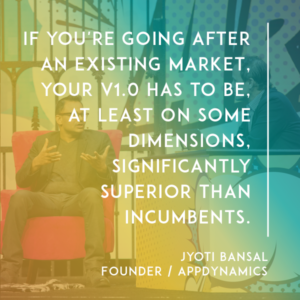
Jyoti: It did. To get the product market fit, it took us about 15 months before we shipped the V1.0. The thing is, APM was an existing market. If you’re going after an existing market, your V1.0 has to be, at least on some dimensions, significantly superior than incumbents.
Jason: Something has to be 10x better. One little piece.
Jyoti: If you are going after a brand new market, you can still start small, because it’s better than nothing. In our case, it was an existing market. There were strong incumbents. I didn’t have an option. However long it took, I couldn’t go out in the market unless something was 10x better.
Jason: Let’s follow up on that. You’ve written a lot about yourself as a 20 something engineer that learned all this stuff, which I want to come back to. You get the product. How did you learn about sales and customer success? What were your learnings there? How did you figure out how to sell into the enterprise?
Jyoti: I’ve written a blog about this. I consider building a startup as series of milestones. You get funding. That’s your first milestone. You get the product market fit to a reasonable shape. That’s the second milestone. You figure out how to sell. That’s your third milestone. You figure out how to scale sales, and then you scale customers, all those kind of things.
To me, it was clear that the enterprise spending is about 80 percent of the market. There were numbers from Gartner and everyone that in our space, 80 percent of the market share is large enterprise and 20 percent is SMB.
To me, it’s like, if I have to win one, it’s better to win the 80 percent of the market share, instead of the 20 percent, so I knew we have to go after large enterprise. Now, it’s like how do you go and sell into large enterprise.
Jason: It’s now like you’d sold yourself into large enterprise, right?
Jyoti: Yeah, so as a first time entrepreneur, the way I’ve learned, is you go and study different companies. I started study how do you go and sell.
If you think of, the whole spectrum is one end is a traditional enterprise software selling, which is that you have these field sales people and they are doing these 12 to 18 month sales cycles. Products that are hard to use, but that take longer deployments, and trials, and all that, and you do $1 million, $0.5 million kind of deal.
The other extreme is where your product is freemium and very simple to use. People do free trials themselves, self service. You have inside sales, at the most, and you go after SMB with that.
Initially, I was like, “OK, I have to pick one of those. If I go enterprise, I have to pick this extreme.”
When I started looking at companies who were trying to disrupt that thinking, I saw some interesting companies who were trying to merge the best of the two. At that time, Splunk was one of the companies that I thought was doing a really good job.
We ended up building that kind of model, which is the best of the two. We’re still going after large enterprise, but we’re a freemium product. People can download our product, and in five minutes could get up and going.
It was kind of land and expand where we’re inside sales, who will sell for like 10K, 20K, 30K, and get people started in 30 day sales cycles. We had very strong field sales, also, who will take those deals and expand into larger, $0.5 million, $1 million deals, which you can’t do without strong enterprise selling.
Jason: You can’t.
Jyoti: If you merge the two, you can still go after large enterprise, but in a very, very different way than the traditional model. What I also did was I ended up hiring the head of sales from Splunk to come and work for our sales force. [laughs]
Jason: You did that? Sometimes, that doesn’t work.
Jyoti: It worked well for us.
Jason: It did work? Chasing the number one at the logo actually worked, right? Was it hard to recruit him?
Jyoti: Not that hard, because he was in the process of getting out of there, so the timing worked out, in some way.
Jason: What were a couple things he did that inflected the curve when you made the right hire?
Jyoti: He was my first head of sales, so we were a zero revenue then. I had $70,000…
Jason: You took him out of Splunk, doing hundreds of millions in revenue, to join a zero revenue? You’re a magician. How exactly do you do that?
Jyoti: Splunk wasn’t as big at that time.
Jason: But $80 million, $50?
Jyoti: They were big.
Jason: It was an iconic company even then, wasn’t it?
Jyoti: It took some selling.
Jason: It took some selling?
Jyoti: It took some selling. I really admired the model he built.
Jason: This is contra to some best practices. Did he close your first customers, or did you?
Jyoti: I had six paying customers in enterprise before I started hiring him.
Jason: You knew how to do it. You had six customers.
Jyoti: I closed the first six myself.
Jason: You said he can do seven to 700?
Jyoti: Yes. I hired him, and said, “Look, talk to these customers. See how happy they are,” the first six customers. It’s much easier to hire a head of sales once you have some paying customers. Otherwise, any good sales guy would not come at that point.
Jason: No one good will come. Still, getting him that early from Splunk, it’s a pretty good move. You’d raised your round at that point, right?
Jyoti: Yes.
Jason: You had the capital.
Jyoti: I had the capital.
Jason: How much did you raise at first?
Jyoti: First round was $5.5 million.
Jason: You said you had to pitch 140 VCs, or something like that?
Jyoti: I think you did that. [laughs]
Jason: I said I had to pitch 150 VCs once. How was it the first time?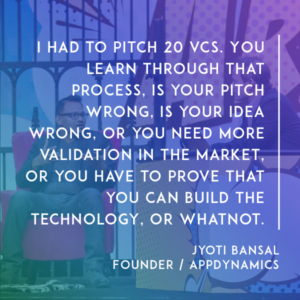
Jyoti: It wasn’t that bad, but I had to pitch 20 VCs. I had to pitch 20 VCs. You learn through that process, is your pitch wrong, is your idea wrong, or you need more validation in the market, or you have to prove that you can build the technology, or whatnot.
It was hard. It was 2008, also, so it wasn’t the best market.
Jason: Crazy time. As then, a 20 something engineer doing your first company, since it’s money day, what did you learn? What was the magic for fundraising? When did you get better at it? What was the hack?
Jyoti: As an engineer, I like to put some kind of a rational framework around things. What is the magic behind fundraising, what you just asked? To me, it really occurred that there’s only three things I need to answer.
One is if I am raising money from the big VCs, which I wanted to raise a series A, I need to convince them that this could be a billion dollar company. It took me some time to learn that, because you would think like if you have a company that’s doing really good business, it doesn’t necessarily have to be a billion dollar, but the VCs don’t want to invest in another one.
Jason: It’s not intuitive at first.
Jyoti: For them, it’s like go big or go home. That’s how the model works. Once that clicked to me, if I need to get money from VCs, I need to convince them that this could be billion dollar business.
Jason: Did you believe it before that, that it would be a billion dollar business, or was it part of your pitch? [laughs]
Jyoti: I did believe in it, but I didn’t make a case for that, because I didn’t think that I would need to make a case for that. You’re a 20 something year old engineer. You go and pitch to VCs that this is going to be a billion dollar business, you are hesitant in the beginning.
Jason: Very hesitant.
Jyoti: I was like, “No, I need to make the case for it,” because that’s what they are looking for. The case has to be reasonable case, not just something you make up.
The second thing is that you have to show as much validation as you can. VCs are always hesitant. Vendors say like, “You’re not ready. Show me more direction,” or something, they want validation from the market. The market, customers, experts, someone.
The third thing I learned is that I need to show why me. If you convince the VCs that it’s a billion dollar space opportunity, you have shown the market validation, VCs still will ask you like, “OK, why should I invest in you?”
Jason: What’s your social proof? Why you?
Jyoti: Yes, what’s your social proof? Do you have a technology advantage over someone? Do you have an expertise advantage over someone? I also had to learn how to talk about that and how to create that proof in some way.
Jason: Let’s go back a little bit in time, because you’ve written about the H 1B process. We’ve threaded a lot of these immigration topics today. What did you write?
It took you seven years to become a founder because of it. Share that for folks that are only half familiar with the process.
Jyoti: A lot of engineers from all over the world, engineers, scientists, come to US on H 1B visa. H 1B visa allows you to work here for a company, but it’s crazy that it doesn’t allow you to quit your job and start a company.
I was here on H 1, and I wanted to start a company. I wanted to be an entrepreneur. That’s something I wanted to do, but you can’t do it, which doesn’t make any sense.
The process of getting a green card could be anywhere from five years to 10 years, which is also equally ridiculous. Imagine someone coming from a top school in India, and they come and do a Master’s in MIT here. Now, they have an idea to start a company, and they’re not allowed to do it for five years, seven years, 10 years. That’s wrong.
I’ve talked about how that needs reform. That’s a screwed up system and needs to reform.
Jason: Would you have left Wily a lot earlier if you could have? What’s the process?
Jyoti: Yeah, I would have left Wily many years earlier and went after doing this.
Jason: How long were you trying to be a founder? How long were you going through that process?
Jyoti: I’ve been working in similar kind of areas. Many times, you have these aha moments, “Hey, there’s a big white space here. There’s a big opportunity here.” I wanted to go after those opportunities, and I couldn’t because of the visa status.
Jason: I should know this. I’ve been through the H 1B with a lot of my team, but remind me. It’s seven years. How do up get to that and found AppDynamics? Remind me, what changes? I should know this.
Jyoti: You get a green card.
Jason: Yeah, of course.
Jyoti: Once you get a green card, you can do that.
Jason: You said about your green card, of course. Got it. Seven years to become a founder. [laughs]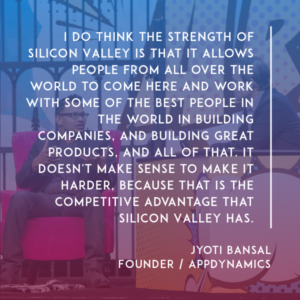
Jyoti: You’ve to get a green card. I do think the strength of Silicon Valley is that it allows people from all over the world to come here and work with some of the best people in the world in building companies, and building great products, and all of that.
Jason: That’s the amazing part, right?
Jyoti: It doesn’t make sense to make it harder, because that is the competitive advantage that Silicon Valley has. That’s why I talk about that we need to reform some of the arcane kind of rules around this stuff.
Jason: What do you think, over the last better part of the decade, what is the competitive advantage of Silicon Valley today? Notwithstanding this horrible immigration drama, is it stronger than before? Is it weakened? What do you think? What do you see?
Jyoti: It remains very strong. The good thing is the startup activity across the world has accelerated. I see it almost everywhere in the world. I see in Europe, I see in Asia, everywhere, even in US, outside of Silicon Valley, there’s so many startup hubs that are starting to emerge.
That doesn’t mean that Silicon Valley has gone down on the startup activity. I do think the startup activity’s increased everywhere.
The Silicone Valley advantage, the venture capital ecosystem is very strong. The talent and immigration, that is still very strong, that you have good talent coming here. You also have the experience, and expertise, and mentorship from other people. That’s very strong framework.
Also, culturally, Silicon Valley, it’s OK to start a company and fail at it. No one looks down on you. That, the cultural aspect, is very key. Everyone wants to try, at least try.
Jason: I want to dig into, because we’re got a lot of folks here, the 20 something engineer. If you go back to your 20 something engineer self, any advice you’d give yourself to do better next time? This was a pretty good outcome.
[laughter]
Jason: What’s your advice for next time? What are the things that you’d advise folks here to do better, to advise yourself?
Jyoti: For a 20 something engineer, the way I was, the advice I give to any founders who are in that stage is that you have to actively work on developing yourself. You have to develop yourself on four dimensions. One is the technology savvy. If you’re doing a technology startup or you’re in the world of tech, you have to be very technology savvy, and you have to be good at it.
Second is, the business savvy, that you’re not building technology or product for the sake of it. The end goal is to build a successful business around it, if you want to be a successful founder. You have to learn the business savviness.
The third is people savviness, that building a company, running a company, being a CEO is all about people. It’s hiring, inspiring, managing, leading, all of that. You have to be very savvy at that.
The fourth thing I tell every technology founder is the sales savviness. The job of a CEO and the founder is selling all the time. You’re selling to your employees to hire them, you’re selling to your investors to raise money, you’re selling to your customers, you’re selling all the time.
I was at a point where my wife would joke about, someone could wake me up at 3:00 in the night and I would do my sales pitch like that. You have to become good at selling, and be very comfortable with it.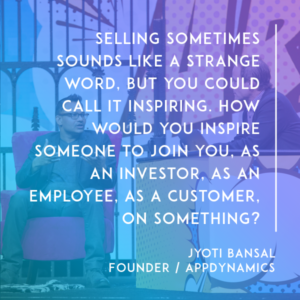
Selling sometimes sounds like a strange word, but you could call it inspiring. How would you inspire someone to join you, as an investor, as an employee, as a customer, on something? You have to become very savvy about it.
That’s the advice it give to every founder that you have to consciously work on developing yourself personally on all those four dimensions. The technology dimension is very natural, but the other things, you have to work on it.
Jason: Selling as inspiring is a good hack to think about how to get comfortable with selling. It can be a tough transition for some.
One topic I’ve learned, I founded a couple of companies that grew quickly, but never anything close to AppDynamics. What I’ve learned is, from companies I’ve been involved with, the faster you grow, the more things break and less the rules work.
What did you learn trying to manage this hyper growth? You got the guy from Splunk, that helps, but how do you manage growing that quickly? What was your revenue ramp? It’s all in some S1 publication, but it was pretty nuts.
Jyoti: It was pretty fast. We grew from, say, 40 employees to 700 employees in four, four and a half years.
Jason: Four years, what was the revenue ramp?
Jyoti: Our revenue grew from, or our sales bookings grew from $2 million to close to about $300 million of annual bookings in that period, in a five year period.
Jason: It’s almost mathematically impossible.
[laughter]
Jason: You’ve got to do sales, you’ve got to close the deal, you’ve got to go get on the plane, you’ve got to talk to people. It’s at the edge of physics here.
Jyoti: The thing I’ve learned about hyper growth is that you want to get the right balance of how much detail you want to manage. If you get the organization into too much detail and planning, you just can’t keep up with it. If you don’t get into any detail of planning, then everything will go in different directions and everything will crash.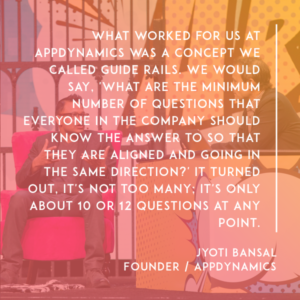
The key is to find the right balance. What at AppDynamics I found that worked for us was, we call it the concept of guide rails. We will say, “What are the minimum number of questions that everyone in the company should know the answer to so that they are aligned and going in the same direction?” It turned out, it’s not too many, it’s only about 10 or 12 questions at any point.
Many times, this will be like, “Who is the ideal user of our product? Is it the persona, is it a developer, is it a DevOps engineer, is it an operations engineer, say, for our kind of product?” If our engineers are building products for a persona one and our sales is trying to sell to persona two, things break.
Jason: …or they don’t do that enough, the 10 to 12 points.
Jyoti: What we used to do was, every quarter, I’ll do an offsite of our management team, just me and my director boards. We’ll get into a room for about four, five hours. We’ll say, “OK, this is the list of questions we need to align ourselves on.”
We will fight, we’ll debate, we’ll argue, we won’t get out of the room until we get alignment on these, but once we get out of this room, we have answers written, very short answers, to these questions, 10 or 12. After that, you do whatever, you figure out the details after that.
You don’t have to micromanage it, but those things, every three months we align, and that worked very well for me.
Jason: How did you distribute that to the company so that everyone knew the 10 to 12…?
Jyoti: We’ll talk about it in the all hands meetings.
Jason: No tests, or quizzes, or anything like that?
Jyoti: You repeat things many times, but no test.
Jason: As engineering gets further and further away from the end customers, that is a challenge. You’ve got to keep them connected to the end customers. Any learnings there, just when you brought it up? I always struggle with that. I made all my engineers do customer support, that was my hack. You had it once for…
[crosstalk]
Jyoti: I totally agree with you. I used to call it, you have to break the walls between engineers and customers. The thing we would do is, we’ll encourage our engineers to visit customers. We had a rotation model, that in every quarter, we’ll do these field trips, you go and visit our customers.
We’re sitting in San Francisco, in Silicon Valley here, and most of our customers are these large enterprises in Wall Street, and insurance companies, or a retailer somewhere, and our engineers have never seen how they do things and how they operate.
Jyoti: What we found is, doing a phone call is not enough. You want to have them, at least once a year or maybe once in a lifetime, go and visit them and spend a few hours and see how they look, and how they operate, and how their day looks like. It makes them so much aligned. We would do those trips and they would work out well.
Jason: Even at your scale, would you have every engineer to that, or was it optional, or mandatory? I like the mandatory. [laughs]
Jyoti: Initially, it used to be mandatory, but then as the organization grew, we made it a bit more optional.
Jason: What happened when they came back from those meetings? Was it somewhat transformational?
Jyoti: Yes. We had a concept, we call Innovation by Embarrassment. If you go to, in front of a customer, and you’re embarrassed about some feature in your product or something, you’ll come back in a day or two, you will just build it. [laughs] You’ll figure out a solution around that.
Jason: Did you make them pitch, too? Did you make them part of a presentation? What did you force them to do in those meetings?
Jyoti: They will go in those meetings and ask the customer, “Hey, how do you use our product? What do you like about it? What you don’t like about it?” and have a conversation there.
The customers will open up and ask questions about, “This, and I don’t like this,” “Why do you don’t do this this way?” With good engineers, if they couldn’t explain why, “Yes, you’re right, it doesn’t make sense. We should’ve done it this way,” then they will come back to office and they will fix it.
Jason: Related to that, as you were at different phases of your scaling, how much time did you spend actually with customers?
Jyoti: I’ve spent a lot of time with customers. The way I managed my time as CEO was, I had this rule of one third, one third, one third. One third time I will spend on the product, with the engineers and on the product, because I was a product oriented CEO and that was my strength. If I wasn’t spending time with product, that wasn’t right.
One third time, I’ll spend with customers, visiting customers and spending time with customers, and one third time, I would call operating the business, which is VCs, and board, and managing the executives, and hiring, things like that. That was my rule of thumb, one third, one third, one third, over any week or month.
Jason: Did you literally plan it out or is that at a gut level?
Jyoti: It was more at a gut level. It’s not that every day you can do one third, one third, or even at every week, you can do one third. Sometimes, you’re doing a fundraising, and you may be doing 100 percent of your time on the third category for a week or two.
Jason: It is hard. Most of us, I find when I talk to founders, they don’t spend enough time with customers. They may spend time in sales, but then they don’t spend enough time after the deal closed with customers.
Related to customers, just because you’ve written about it and you have the passion, so it sounds like you have a passion around NPS and measuring customer happiness. What are the secrets there, to customer happiness, or what have you learned around that?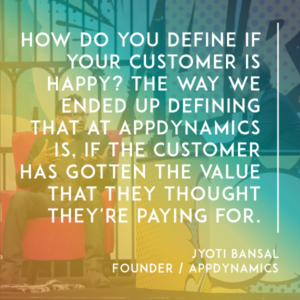
Jyoti: What we learned at AppDynamics as the secret is that, how do you define if your customer is happy? The way we ended up defining is, if the customer has gotten the value that they thought they’re paying for. If they’d gotten the value that they thought they’re paying for, they will be happy, most likely, and recommend to you.
How do we become systematic about it? When you’re selling into large enterprise, almost all the time, before the sale, you create some RoI model or some business case that, if you spend $100,000 with us, you’re going to get $300,000 worth of return of your money in three years, something like that, but rarely any company goes back after the sale and proves that they delivered that RoI.
We adopted a process which was unique at that time, that we would go three months after the sale and six months after the sale, and we’ll sit with the buyer and say, “This was the RoI that we built together before the sale, let’s see how are we doing on it.” We’ll fill out the spreadsheet to see…
Jason: If you deliver what you claimed you’re going to deliver to the customer.
Jyoti: If we delivered what we claimed, the customers were happy. Sometimes, you can’t deliver what you claimed. Things happen, it could be our fault, it could be customer’s fault. Then, we would say, “If we didn’t deliver what we…or we are not tracking towards delivering that, let’s build a plan together, and go and make it a joint goal to get there.”
Customers always liked it, that we were holding ourselves accountable to delivering the value we promised. To me, that’s been the secret of, how do you get high NPS scores. If some way you can ensure that you delivered what you promised, customers will be happy.
Jason: You go back at month three and month six, and have an honest assessment of, “Did we deliver?” and when you went back, and some of those customers were angry because the sales guys said something that wasn’t true or the product didn’t work, when you went there, did you ever lose them, when you actually went there, because I find you don’t lose too many if you get out there and go through this, no matter how angry they are? [laughs]
Jyoti: Exactly right. If you go and talk to them and say, “Hey, let’s see if we did deliver the value or not,” and they say, “You said we will give this value and we haven’t got it,” and we’ll say, “OK, let’s see, can we remediate it, can we fix it?”
If you have that conversation that we are serious about remediating it, customers like that. You don’t lose them if you’re serious about it.
Jason: An interesting question related to that, because it’s interesting, so you segment your customers into this inside sales and the field group, how do you force rank priorities, because there are conflicts, there’s sales, there’s engineering. Maybe there’s not a conflict, but the enterprise piece is bigger. How do you manage those conflicts, if at all?
Jyoti: The model that we adopted was, we were selling into enterprise, we were not selling into SMB, unless some opportunistic deal. What we were doing was, we were doing it by the deal size. If the deal was less than $75,000, our inside sales will take the lead and run it.
Jason: Even if it’s IBM?
Jyoti: Even if it’s IBM, with some exceptions. There will be some accounts which will be exceptions sometimes.
Jason: Google gets the better treatment.
Jyoti: Yes, but very few. Normally, if the deal is less than $75,000, our inside sales will do it. If the deal is bigger than that, it’s a bigger opportunity than that, then our field sales will do it. Many times, we’ll pair them up. There’s a pairing of an inside rep and a field rep, who will do together after a territory.
Jason: One other question on this, sounds like you knocked it out of the park on your VP of Sales, so you’re ahead of over 70 percent of folks here, because our unscientific survey is that 70 percent of your first VP in Sales don’t make it six months.
[laughter]
Jason: When you were hiring, what were some of the hires that you made that were wrong, what were some of them? You made the Splunk thing work, any mistakes that you learned? Did figuring out how to hire a VP of Product not work out, or was marketing a challenge?
Jyoti: Not all hires go right. I would say, about seven out of 10 or six out of 10 is probably the right hit rate. I don’t think 10 out of 10 would go right on hires, on execs, I think it’s impossible.
Jason: No big one you learned? One big mistake?
Jyoti: Sometimes what happens is, some people are good at a certain stage, but they’re not good at a different stage. That also happens. It’s not that they didn’t work out right then, but they…
Jason: That’s a hyper growth topic. When you’re in a hyper growth mode, how far does the executive have to scale, because it’s hard to scale from one to 300? What are your learnings? Do they have to scale 18 months, or do you hope they scale?
Jyoti: It’s an interesting question. The way I always started to look at it, that instead of asking the question like how far someone scales, what does it mean, or what are the skills required? We had known that we’re going to the next level, what do they lack? Do they lack ability to inspire a larger number of people, do they lack the amount of planning or strategic thinking needed for the larger role?
They are not good at hiring or delegating? What are they lacking that would stop from the next level?
I would ask like, “Can this be coached? Can they be coached on it?” Sometimes, you can’t coach someone because that’s how they are. That’s how they’ve operated, or that’s their personality for 20 years. You can’t coach it.
Jason: A lot of people don’t want to be coached.
Jyoti: Based on, “We need this skill and this skill cannot be coached,” so we have to make a change.
Sometimes, it could be coached, but you may not be able to afford the time to coach. If it will take a year to coach, and we don’t have a year, or this person is in such a critical role that we don’t have a year. We have to make a change.
It’s a hard question. The hardest question is when things are going well, in the hyper growth and you have to bring someone for the next level of skills.
Jason: It is hard. Did you get any coaching, or mentors, or folks that helped you scale? Did you find anyone great to help?
Jyoti: Unfortunately, I couldn’t find one coach.
Jason: I was bad at it.
Jyoti: I wish I had one mentor or one coach like that. I would go and talk to a whole bunch of people. You read, and study, and you talk to a whole bunch of people. The way I learned is it’s best to pick a topic and see who can you talk to about this particular topic.
Let’s say our topic is, “We are going to expand internationally. How should we think about our international expansion strategy?” Then, you’d go and try to find seven or eight people.
If you talk to eight different people who have done that, you start getting a good idea on…
Jason: Seven or eight.
Jyoti: Yeah, if you talk to one or two, you still may not know. Even though they have been successful in their role somewhere, it may still be a wrong approach.
Jason: It’s not enough. You always have to push yourself to do more of those meetings. On that topic, because of our audience, any interesting lessons on that, going international? Did you do it too early, too late? Did you staff it wrong?
Jyoti: I would say for most software companies, international expansion these days is easier because of SaaS and online…
Jason: Sometimes, it’s organic.
[crosstalk]
Jason: You can buy software anywhere.
Jyoti: That’s the test we had. If we are seeing three downloads coming from a country, that means that country has demand for our stuff, so let’s go and do after it.
The advice I would give, though, is pick the biggest countries and the biggest geographies. If you have to go to Europe, pick the top three: UK, Germany, and France and start with that. Don’t go after every country in Europe initially, until you nail the bigger economies.
Same thing in Asia, if you’re going in Asia, try to nail the easier and bigger economies, and then you expand from there. Otherwise, it takes too much resources.
Jason: It’s the same amount of resource, no matter what the market is.
I know we blew through time. Any high level thoughts? What kind of advice can you give, especially to the 2,000 folks from other countries? What’s some Zen thoughts for us on the journey to $3.7 billion?
Jyoti: My advice is simple. You can’t plan it all, but you have to do it one step at a time, one milestone at a time. Have the plan at a high level, but then focus on how do we achieve this next major hurdle.
If your hurdle is that you need to go and nail the first set of customers in some vertical, or you need to go and expand into this country, or you need to raise this capital, you have to find a way to nail that hurdle. You keep doing it. You get to the next hurdle, and next hurdle.
Jason: Break it up into hurdles and pieces, otherwise, it can be overwhelming, can’t it? [laughs]
Jyoti: It’s overwhelming. You go after one hurdle at a time, and you keep building on it.
Jason: The last question, I know we’re over, but when did you know AppDynamics is going to make it? When did you feel it?
What did it feel like at the moment when hyper growth hit? Did you know it? What was that switch that happened when you knew the company was going to be a big hit?
Jyoti: The first 18 months, it was hard. We didn’t know if people are going to buy our product. We were going through pivots and transformation of what we are going to be even, so that was hard.
Once we got the product out, I could see customers were happy and excited. That meant, to me, was I knew we could do it. I remember, at that time, billion dollar valuation or unicorn was very rare.
Jason: That’s why they called them unicorns, remember? That was the old days.
[laughter]
Jyoti: Now, you have 150 of them. In 2010, when we launched the product, I said, “Hey, we’re going to be a billion dollar company.” We were 12 people in the company.
People were like, “What are you talking about?” I said, “Hey, look at our product. People like our product. We’re going to be a billion dollar company. Let’s set that as our goal.”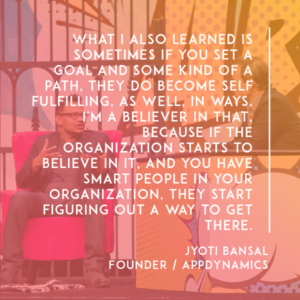
What I also learned is sometimes if you set a goal and some kind of a path, they do become self fulfilling, as well, in ways. I’m a believer in that, because if the organization starts to believe in it, and you have smart people in your organization, they start figuring out a way to get there.
Jason: They do.
Jyoti: I remember, in 2010, I said, “We’re going to be a billion dollar value company.”
Jason: With 12 people?
Jyoti: With 12 people. People were like, “Are you crazy?” but then, I repeated it so many times, “OK, this is how we will get there.” A billion dollar valuation is about $150 million of revenue growing fast for a B2B company. We said, “OK, this is how we go to $150 billion dollars,” and people start seeing it.
The best thing was I didn’t need to tell them every detail. Once people believed that we can go there, they started figuring out, “Hey, we have this problem. If we don’t solve this now, two years from now, we can’t get there.”
The organization starts to do it. It’s crazy how, once the organization believes in that goal, they start to figure out ways to get there.
Jason: That’s the key. If you set the goal too low, you’re going to align to that low goal. That’s great. Let’s all do that. Let’s give it up for Jyoti. This is an amazing story. Thanks to everyone, super cool.
[applause]
Jason: Thanks for doing this. This was great.

